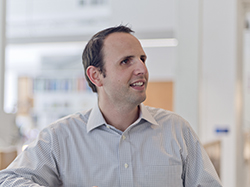Architect Q&A: Mastering the Master Plan
Master planning is critical to the long-term success of a school or university campus, and helps ensure all facilities are operating effectively and efficiently. Today, many architecture and planning firms list master planning among their specialties, and School Construction News spoke with representatives of two leading companies to learn more about their unique approaches to planning attractive, yet highly functional, campuses.
Tyler Patrick, AICP, is a principal with Watertown, Mass.-based Sasaki Associates Inc., which works primarily with higher education clients planning both facilities and detailed campus master plans. Nate Appleman AIA, LEED AP, is director of Sports + Recreation + Entertainment for the Kansas City office of HOK, which offers both architectural and planning services as well.
Q. What technology or modeling programs have been most useful to your firm in crafting master plans?
 Patrick: We actually have an in-house team of programmers, Sasaki Strategies. They help us to create tools. We don’t necessarily develop generic tools for every institution; we’re more interested in developing custom tools to explore certain issues. What we’re trying to do is provide access to a visualization of data, in some cases where data doesn’t exist, to develop tools where we can create data. That means sometimes we’re creating interactive mapping surveys. We have a survey tool called My Campus that we use in order to understand how people use the campus. By making it map-based we can really understand use patterns.
Patrick: We actually have an in-house team of programmers, Sasaki Strategies. They help us to create tools. We don’t necessarily develop generic tools for every institution; we’re more interested in developing custom tools to explore certain issues. What we’re trying to do is provide access to a visualization of data, in some cases where data doesn’t exist, to develop tools where we can create data. That means sometimes we’re creating interactive mapping surveys. We have a survey tool called My Campus that we use in order to understand how people use the campus. By making it map-based we can really understand use patterns.
Appleman: Three-dimensional modeling is important to communicating intent with clients who aren’t used to looking at architectural plans. These programs allow them to understand a project’s scope, program and size very effectively. At times, we create low-tech, physical models to look at specific planning issues and building placement so we can truly see and appreciate the building’s form and location on a site in relationship to other buildings on campus.
Q. What methods have you employed to develop a plan that met a school’s needs while also adhering to a tight budget?
Patrick: Increasingly what we’re seeing is an emphasis on renovation and strategic reuse of facilities rather than building new. Part of the problem is an increasing deferred maintenance backlog that colleges and universities are facing. If they can renovate to improve the quality of a space and reduce that deferred maintenance backlog that is key. We look at a building and ask, ‘What is it best suited for?’ It may have been created as a lab building or library, but isn’t meeting those needs anymore. So, can it be repurposed as an administrative office building? Can it be better used as a classroom building? We’re always looking for high value solutions for the client so that they can best use their existing resources.
 Appleman: What’s important to remember is that “improve” does not always mean “new.” With every master plan we do, we always challenge our clients to think about assets they currently have and help evaluate how viable those assets are long-term. This begins a critical discussion about building new vs. renovating or expanding existing facilities. It’s a case-by-case basis, but often adhering to a tight budget means converting existing assets to serve a new purpose that meets the needs and budget of the department and university.
Appleman: What’s important to remember is that “improve” does not always mean “new.” With every master plan we do, we always challenge our clients to think about assets they currently have and help evaluate how viable those assets are long-term. This begins a critical discussion about building new vs. renovating or expanding existing facilities. It’s a case-by-case basis, but often adhering to a tight budget means converting existing assets to serve a new purpose that meets the needs and budget of the department and university.
Q. How will environmental sustainability continue to impact master planning on both the K-12 and university levels?
Patrick: Sustainability is ingrained in everything we do. We don’t think of it just in terms of environmental sustainability, but financial, social and environmental sustainability as well. We try to look at all those factors together to bring a balanced approach and solution. We’re looking at decisions around transportation impact demand for parking and what that means in terms of single occupancy vehicle trips. We’re thinking about the impact of impervious areas on campus, about giving back to the community and the role that universities and colleges play as community stewards. I think that the master plan at the broadest sense has to embrace all of those things, so that as individual initiatives are developed there’s a framework to support that sustainable lens through which things should be looked at.
Appleman: Sustainability will continue to be a key priority for master plans on college campuses and will continue to evolve. This is particularly true for sports facilities, which are often anchors for a campus community. Just a few years ago, universities and municipalities asked about how to reduce water use, minimize waste, save energy and reduce costs. Looking to the future, next-generation campus facilities must now go a step further to create and produce; enhancing the habitat, generating water, creating resources, harvesting energy and adding lasting project value. Ideally, the collegiate stadiums and recreation centers of the future will generate more energy than they consume, providing surrounding businesses and mixed-use developments with valuable resources from which to draw.
This article was originally published on School Construction News.
